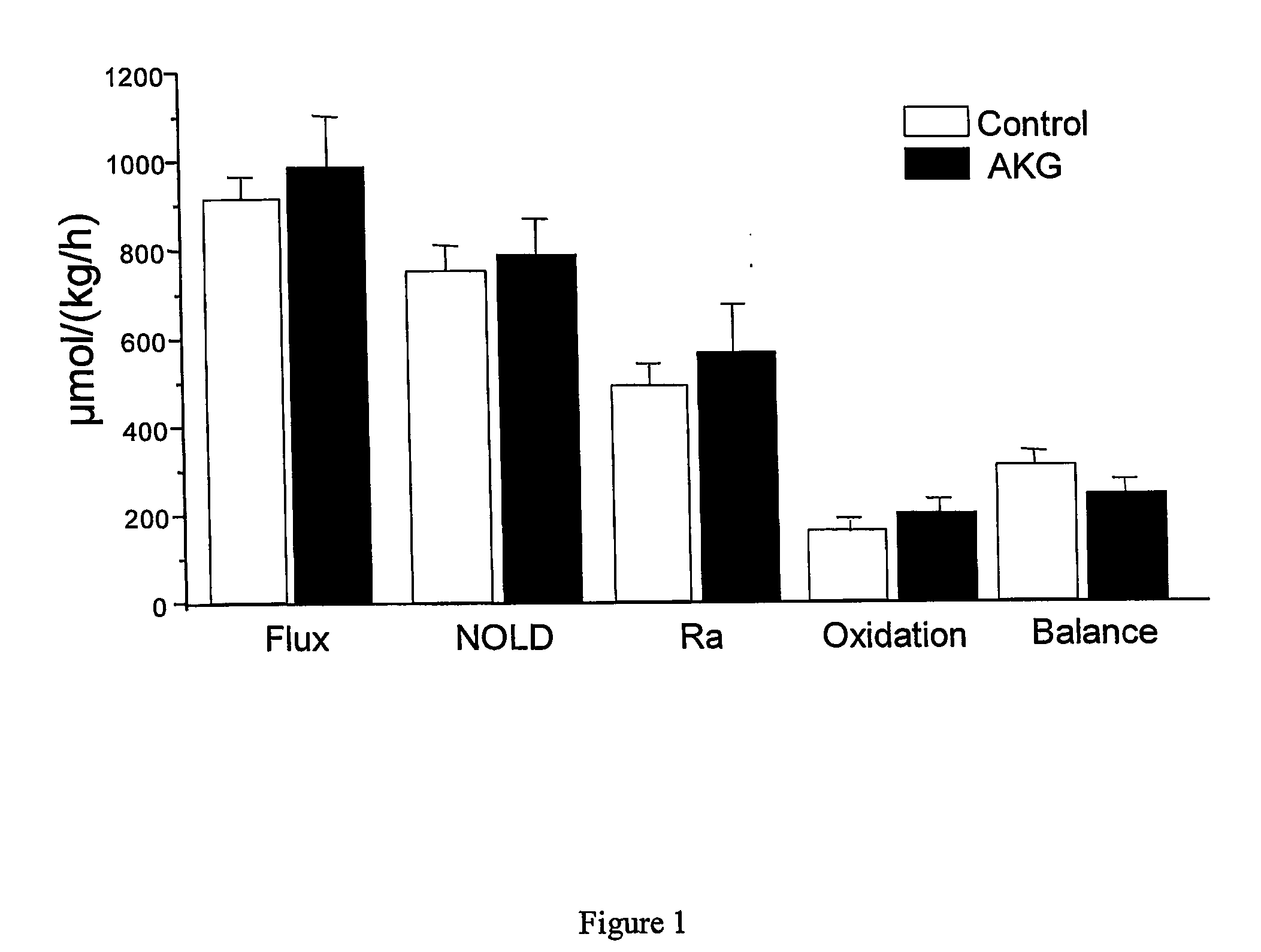Use of alpha-ketoglutaric acid for the treatment of malnutrition or high plasma glucose condition
a technology of alpha-ketoglutaric acid and malnutrition, which is applied in the direction of drug compositions, peptide/protein ingredients, metabolic disorders, etc., can solve the problems of increasing the risk of diabetes, so as to prevent diabetes, inhibit or alleviate the effect of high glucose condition
- Summary
- Abstract
- Description
- Claims
- Application Information
AI Technical Summary
Benefits of technology
Problems solved by technology
Method used
Image
Examples
example 1
Measurements of Plasma AKG, Glucose, Amonia, Blood Flow and Whole Body Urea Flux
Objective
[0181] The objective of this example is to evaluate the effect of AKG infusion on plasma AKG, glucose, amonia, blood flow and whole body urea flux.
Animal Experiments
[0182] Piglets were deprived of food for 15 h before initiation of the experiment.
[0183] On the day of the experiment, at time −1 h, a primed (7.75 mL / kg; 25% wt / wt aqueous solution; oral), continuous duodenal infusion of milk replacer [Litter Life, Merrick, Middleton, Wisc.; 7.75 mL / (kg·h)] prepared as a 25% (wt / wt) aqueous solution which provided ˜920 kJ and 12.5 g protein / (kg d).
[0184] Either saline (control; 930 mmol / L NaCl) or sodium-AKG (Na-AKG), 930 mmol / L, from Sigma-Aldrich, St. Louis, Mo.) were dissolved in the milk replacer.
[0185] The level of AKG was chosen based on previous data (6) from out laboratory, where intakes of greater than 2.5% of diet dry matter was required to observe a detectable portal balance of A...
example 2
Measurements of Mean Luminal Disappearance of AKG
Objective
[0198] The objective of this example is to evaluate the mean luminal disappearance of an infused AKG bolus.
Animal Experiments
[0199] Pigs (n=7) were given a duodenal bolus infusion (7.75 mL / kg; 25% (wt / wt) aqueous solution) of liquid milk replacer (Litter Life, Merrick) containing 25 mg / mL sodium AKG (1040 μmol / kg BW).
[0200] After 1 h, pigs were sacrificed.
[0201] The small intestine was carefully clamped at the proximal duodenum and distal ileum, removed and flushed with 2×50 mL of saline to wash the intestine.
[0202] The washes were collected, pooled, and a 15 mL aliquot was flash frozen in liquid N2 and stored at −80° C. for later AKG analysis.
Results
[0203] An AKG bolus of 1040 μmol / kg was infused. The mean luminal disappearance was 663±38 μmol / kg in one hour. This represents 63.8 of the 1040 μmol / kg of infused AKG.
experiment 1 and 2
Discussion and General Conclusion of Experiment 1 and 2
[0204] In Example 1, AKG was continuously infused into the duodenum and only 10% of the infused AKG appeared in the portal venous drainage.
[0205] The observation that only 10% of infused AKG appeared in the portal plasma raises several possibilities as to the fate of luminal AKG. One possible explanation for the low AKG portal appearance is that luminal AKG transport is limited. Sodium / dicarboxylate cotransporters, which are capable of transporting AKG, exist on pig brush border membranes (9), so it seems unlikely that AKG would not be taken up by the enterocytes. To test this, we infused a single duodenal bolus of 1040 μmol / kg and found that over 660 μmol / kg disappeared from the small intestine of piglets in 1 h (Example 2). Thus, approximately 64% of the AKG bolus had disappeared from the lumen of the duodenum in only 1 h.
[0206] The net portal appearance of glutamate and glutamine were not affected by AKG infusion as observe...
PUM
| Property | Measurement | Unit |
|---|---|---|
| concentrations | aaaaa | aaaaa |
| concentrations | aaaaa | aaaaa |
| volume | aaaaa | aaaaa |
Abstract
Description
Claims
Application Information
 Login to View More
Login to View More - R&D
- Intellectual Property
- Life Sciences
- Materials
- Tech Scout
- Unparalleled Data Quality
- Higher Quality Content
- 60% Fewer Hallucinations
Browse by: Latest US Patents, China's latest patents, Technical Efficacy Thesaurus, Application Domain, Technology Topic, Popular Technical Reports.
© 2025 PatSnap. All rights reserved.Legal|Privacy policy|Modern Slavery Act Transparency Statement|Sitemap|About US| Contact US: help@patsnap.com


